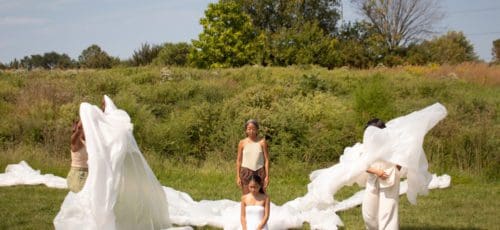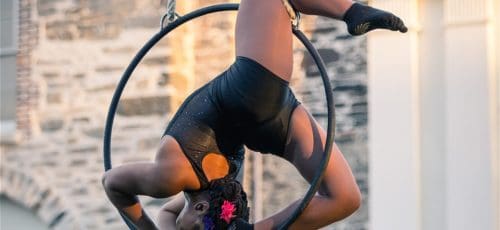The Photo That Launched A Thousand Ticket Sales
I am at a cafe because of an anointed brunette. I have driven across the city—Northern Liberties to the Italian market—and renegotiated time and place. She’s angelic, but she’s not churchly: in the photograph a trailing cord of electrical wire barely covers the nipples of her large breasts, and she holds a drill in front of a G-string whose color so closely mirrors her skin-tone I’m convinced she’s not wearing anything. Except her high-heeled patent leather boots.
I am at a cafe because of an anointed brunette. I wait. Gunnar Montana texts me: “I’m here a little early.” I’m here too I text back, and scan the cafe for the face behind this oiled woman—all at once, this is everyone. The low-talking, skinny young man behind the counter. The bleached blonde woman in the corner. But not Gunnar; he’s missed my text, walked in and out, and gone elsewhere to kill time: “Oh shit! / I just ordered a beer at the pope / Let me chug that real fast unless u wanna join me.”
I gulp my blackberry vegan yogurt smoothie. If I don’t drink it fast enough the dairy might grow back. Four minutes later he joins me, and folds himself into the blue-green cushion of the window seat. We share its body-length, facing off. His right arm he drapes over the windowsill, and crosses his left leg over his right; Gunnar, artistic co-director (along with Jazmin Zieroff) of 2012 Philly Fringe’s RUB, is young, confident, and at ease.
“Right now I have this,” he says, picking up from the floor a round metal object: a silver star, oiled and dirty, encircled with the same metal. Gunnar had carried it with him to the cafe, walking his bicycle (because of a flat tire) in the other hand. I had driven.
“Is that a hubcap?” I ask.
“I guess. I don’t know what it is,” he says, laughing. It doesn’t last for long; Gunnar’s chuckling never seems to fully inhabit his face. “I found it on the street.”
After the jump: dancing, gender, work, and, you know, dancing.
The Fringe submit is Gunnar’s first show, though he’s no Johnny-come-lately to performance: a 2011 graduate of the University of the Arts with a degree in modern dance, Gunnar is entering his fourth year as a member of Brian Sander’s JUNK. The company’s The Gate Reopened is a part of this year’s Live Arts Festival.
“Doubling up on shows is probably one of the crazier things I could do, but I’m young. [Brian’s] stuff is always really dangerous and really draining but it’s always so inspiring. It’s probably been one of the easier projects I’ve had to do because there’s so much artistic energy in the air that you just use it. You just go for it.”
Beneath his copper-singed light brown crop and moustache-beard, Gunnar wears a black Rock of Ages’s Arsenal band T-shirt, and it’s sleeveless: “I make all my art, and all my clothes out of trash. Trash day is definitely a very exciting day,” he says. “Especially if you’re in Rittenhouse at the time.”
His trash picking might just be emblematic of his and his fellow recent graduates’ (this girl included) economic plight. Artists struggle with perhaps the worst unemployment numbers; in 2009 the National Endowment of the Arts found that professional artists faced unemployment rates double that of workers in other fields.
“Nobody’s really getting jobs, dancers really aren’t getting jobs.” Gunnar’s eyes protrude when he is emphatic (which happens often when he talks about RUB and the show’s back-story) and they are only a shade darker than his hair; Gunnar seems cast from a crucible of melted pennies.
“I’m seeing a lot of my friends getting out of school and going straight to the strip clubs because they need to pay their rent,” he says.
For RUB Gunnar, along with co-director and burlesque performer Jazmin Zieroff, are culling inspiration from their female friends and creating a strip performance, one that refigures the act of strip tease: “When you think of people who are watching striptease, you think of dirty old men with lots of money,” Gunnar says. “You see these girls and you’re like, ‘OK, they’re trash. They have no self-esteem. They’re just doing this to make money so they’re superficial. All they care about are their shoes and sex and they’re going home with their customers.’”
Hoping to subvert these ideas under the Fringe umbrella, Gunnar and his four-woman cast enter into a dynamic debate: can the act of stripping be empowering for women? It is a dialectic so buzz-worthy its been covered by popular media: the U.K. edition of The Huffington Post runs an interactive debate on the topic, where readers can vote “Agree” or “Disagree” before reading both sides of the argument. Then, readers are given the chance to recast their votes.
The Huffington Post coverage relies on personal essay, because for many the nuances are only unpacked by experience. In her essay “Just a Stripper” (published on the contemporary feminist blog The F Word), Natasha Forrest narrates the voices that ping-pong back and forth (empowering, not empowering) when she considers her time as a stripper. “By showing my vagina,” she writes, “I was challenging the patriarchal taboo against female nudity. By making men pay to see me naked I was making the economic power dynamics underlying normative heterosexual behavior explicit.” She argues that in theory, stripping as female empowerment can exist, but in the existing economic system, it’s stifled and merely a feminist dream: “as long as our wages rely on pleasing our customers, gender subversion can only go so far,” Forrest writes.
The question is talked raw in academic circles as well, where the debate is not about whether stripping empowers women or disenfranchises them, but rather by positing that it might do both, asks how does it function? Post-structuralist feminist theorist Judith Butler for example, in her essay “Performative Acts and Gender Constitution: An Essay in Phenomenology and Feminist Theory,” concerns herself with how gender is constructed—Butler argues that gender is not determined by being male or female, but by the performance of masculinity or femininity—and not the social repercussions of one gender being naked in front of people paying to see their erogenous parts.
Some of Gunnar’s subversive tools are literal, such as his idea to have one of his performers wear a dress made of single dollar bills, and to tip the audience with them as she removes the garment. Others are looser in meaning, and loyal to Gunnar’s grit aesthetic: “My work is very grungy, it’s very dark, and it’s very robotic. We’re giving [the dancers] characters that would be coming out of the apocalypse as if they were robots you would make as sex slaves, and then the human race dies out and they’re the last ones left.”
My mind is spinning with the visual possibilities of a post-civilization strip show, but I’m interested in the human; I want to know more about my anointed girl.
It goes like this: Gunnar wakes up one morning, the soft-core image—like many others of dreams before—a dimming picture he must find in the real world: “I call up my dancer and beg my boyfriend to get out his camera and start shooting. We put on a Pandora play list of The Glitch Mob and grab anything in sight that strikes us. [We end up] wrapping her up in a hand drill cord and sitting her on a milk crate, drenching her in baby oil and wetting her hair with dollar store hair gel. I always have my girls wear their own shoes and panties: The g-string in the picture is embellished with about $200-worth of Swarovski rhinestones, and the shoes just happen to be the same ones Lady Gaga wore in her ‘You & I’ video. I don’t mind; I love a little Gaga.”
In conversation, Gunnar frequents his future: choreography for RUB, rehearsals with JUNK, stumbling upon that next great find in the recycling bin. He doesn’t much occupy his past, or his Montanan hometown (a history that constitutes his adopted stage persona’s surname; his given name is Gunnar Clark).
“I grew up in Trout Creek. It’s in the northwestern part of the state,” he writes, in an e-mail exchange post-interview. “It’s the definition of a small town with big skies, small minds, and plenty of pickup trucks. It’s three hours from the nearest Walmart.” And the boundary-pushing performances the chain attracts to its aisles.
RUB runs September 7, 16, and 20 at 10:00 pm and September 8, 9, 13, 14, 15, 20, and 21 at midnight, at The Latvian Society, 531 N. 7th Street. $20.
–Audrey McGlinchy




